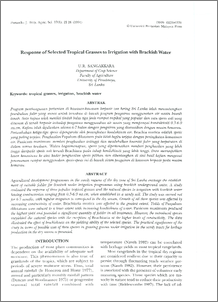Citation
U. R., Sangakkara
(1994)
Response of selected tropical grasses to irrigation with brackish water.
Pertanika Journal of Tropical Agricultural Science, 17 (1).
pp. 21-26.
ISSN 0126-6128
Abstract
Agricultural development programmes in the sandy regions of the dry zone of Sri Lanka envisage the establishment
of suitable fodder for livestock under irrigation programmes using brackish underground water. A study
evaluated the response of three popular tropical grasses and the natural species to irrigation with brackish water
having conductivities ranging from 0.5-6.0 ms. cm, when established in a sandy soil. The study was carried out
for 6-7 months, with regular irrigation to correspond to the dry season. Growth of all three species was affected by
increasing conductivity of water. Brachiaria mutica was affected to the greatest extent. Yields of Paspalum
dilatatum were reduced to a lesser extent with increasing brackishness of water. Panicum maximum produced
the highest yield and provided a significant quantity offodder in all treatments. However, the introduced species
outyielded the natural species with the exception of Brachiaria at the higher levels of conductivity. The data
illustrated the effect of brackishness on the yielding ability of the selected species. The practical significance of the
study in terms ofpossible uses of these species in growing grasses under irrigation in the sandy tracts for herbage
production in the dry season is presented.
Download File
![[img]](http://psasir.upm.edu.my/style/images/fileicons/application_pdf.png)  Preview |
|
PDF
Response_of_Selected_Tropical_Grasses_to_Irrigation_with_Brackish_Water.pdf
Download (3MB)
|
|
Additional Metadata
Actions (login required)
 |
View Item |

